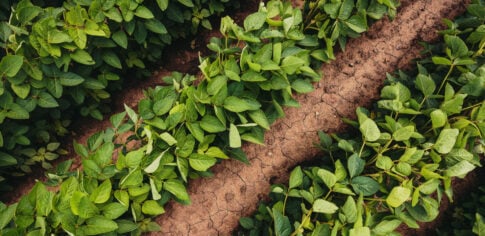Growing Soybean
Crop Nutrition Advice
Everything you need to know about soybean fertilization, best practice, suitable products, field trials and more.
Crop nutrition for growing soybean (Glycine max)
-
Annual crop belongs to family Fabaceae (Leguminosae).
-
Plants with one or more stems, Plants with one or more stems, where the trefoils develop. In the nodes, flowers are formed that will generate the pods, which contain the grains or seeds.
-
Plants have pivoting root system, depth up to 1.80 m, 60 to 70% at 0.15 m depth. Presence of nodules in roots, where biological nitrogen fixation occurs.
-
Grains in pods, with general content: oil: 17% to 22%, protein: 38% to 45%, carbohydrates: 30% to 35%.
-
The crop development stages are defined as: vegetative stage (described as VE to Vn) and reproductive stage (described as R1 to R8).
-
Soybean requires a well-drained loamy soil for proper growth. In compacted soils, hypocotyl breaks easily during emergence if under pressure. The root system will not be deep.
-
Better development between 20°C and 35°C. Temperature below 15°C can cause impairs germination and emergence, with potential diseases increment. Temperatures above 40°C have an adverse effect on the growth rate, disturbances in flowering and decrease the capacity to retain pods. These problems are accentuated by the occurrence of water deficits.
-
Water demand for high soybean yield is around 700 mm of rainfall (ideal distribution of rainfall should be 200 to 250 mm – 35% - during vegetative growth phase and 450 to 500 mm – 65% - during the reproductive phase).
-
Lack of water for some days during flowering (dry spells) - dramatically reduction in yield, especially in sand soils and in areas where the root system is superficial due to calcium deficiency or aluminum toxicity in depth (In Brazilian Cerrado there are reports of losses ranging from 10 to 70% depending number of days with a lack of rain).
-
Dry weather is necessary for ripening.

Young soybean plants

Soybean crop rows
Nutrient requirements Requirements in temperate region, Mollisols, USA
| Part of plant | N kg/t | P kg/t | K kg/t | Ca kg/t | Mg kg/t | S kg/t | B g/t | Cu g/t | Fe g/t | Mn g/t | Zn g/t |
|---|---|---|---|---|---|---|---|---|---|---|---|
| Grains (offtake) | 59 | 11.5 | 2.6 | 11.6 | 2.6 | 3.4 | 32 | 11.6 | 72 | 28 | 42 |
| Other parts | 23 | 3.2 | 29 | 31.6 | 12.6 | 2.3 | 64 | 7.2 | 181 | 92 | 59 |
| Total (uptake) | 82 | 14.7 | 52 | 34.5 | 15.2 | 5.7 | 97 | 18.8 | 253 | 120 | 101 |
| % offtake | 72% | 78% | 44% | 8% | 17% | 60% | 33% | 61% | 28% | 23% | 41% |
Requirements in tropical region, Oxisols and Ultisols, Brazil.
| Part of plant | N kg/t | P kg/t | K kg/t | Ca kg/t | Mg kg/t | S kg/t | B g/t | Cu g/t | Fe g/t | Mn g/t | Zn g/t |
|---|---|---|---|---|---|---|---|---|---|---|---|
| Grains (offtake) | 54 | 4.8 | 18 | 2.8 | 2.5 | 2.8 | 31 | 11.5 | 65 | 39 | 41 |
| Other parts | 24 | 2 | 30 | 1.3 | 8.2 | 1.4 | 51 | 8.3 | 310 | 159 | 34 |
| Total (uptake) | 78 | 6.8 | 48 | 22.1 | 10.7 | 4.2 | 82 | 19.8 | 375 | 198 | 75 |
| % offtake | 69% | 71% | 37% | 13% | 24% | 66% | 38% | 58% | 17% | 20% | 55% |
Dynamic of nutrient uptake over a crop season in soybean
Soybean has been grown in the most varied types of soil in the world, for example Molisols and Alfisols (neutral to alkaline, with high fertility) to Oxisols and Ultisols (acidic, with low fertility). It is important to correctly manage the fertility of each type of soil to seek profitable production for the producer.
Very similar in terms of offtake nutrients in the regions, except to P, higher in grains in richer soils.
Dynamic of nutrient uptake
- Increment of uptake during pods and grain development
- N, P, Ca and Mg – 50-55% of uptake until R4; 45-50% after)
- S – 45% until R4 (55% after)
- K2O – 50% until R2 (50% after)
- Possible higher response to split fertilization in sand soils (specially to K2O and S), part in band on sowing and part in top-dress 2-3 weeks after)
- Other possibility – use of prolonged availability fertilizers

Source: Bender et al., 2015, USA.Average for 3 varieties and yield 3.4 t/ha
Role of nutrients
Nitrogen
Is the most important plant nutrient for the soybean crop, and the one that is required in largest quantity. 80 Kg of N is needed to produce 1,000 kg of soybean. However, most of the requirements for N are covered by the nitrogen from the air through the symbiotic fixation by the Rhizobium bacteria in the nodules on the plant’s roots.
The biological fixation can supply all the N required by the soybean plant, but due to price concerns it is normal to apply some N fertilizer, but it is important that this quantity does not surpass 20 kg N/ha.
Phosphorus
Has a function in the plants directly related to energy storage.
It is essential in the absorption of nutrients from the photosynthesis and for its role in the buildup of organic compounds of high energetic value, and for soybean this means the oil.
Potassium
Is important for the for the construction and transport of carbohydrates, and it also influences the reduction of diseases, hence a sufficient supply will help support a healthy plant.
Calcium, magnesium, and sulfur
Are important nutrients for root growth, photosynthesis and the formation of the grains, respectively.
Molybdenum
Is a constituent of the enzyme nitrogenase in the nitrogen fixing bacteria, and together with cobalt it is essential for efficient nodulation and biological fixation.
Thus, supplying these micronutrients has become a basic practice on most soils where soybean is grown.
Manganese
Special attention should be given to it, as there is an increase in deficiencies in the crops.
Reduction in the uptake of this nutrient is due to the use of RR (Roundup Ready – Glyphosate tolerance) varieties, and excessive liming.
Boron
Has an important role in the pollen’s germination and the growth of the pollen tube.
In the case of deficiency or hidden hunger for boron, the grain production will be adversely affected.
Nutrient deficiencies
Nitrogen
Total chlorosis of older leaves followed by necrosis. Low protein content in grains. In the absence of molybdenum (Mo) there is a deficiency of N.
Phosphorus
Plants with reduced growth, low insertion of pods and older leaves with a bluish-green color.
Potassium
Internerval chlorosis, followed by necrosis on the edges and apex of old leaves, due to the formation of putrescine; the plant shows appearance of burning by fire, herbicides. Small, wrinkled and deformed grains with low vigor and low germination power.
Calcium
Membrane becomes “porous”, breaking cell compartments and losing selectivity for desirable ions and absorbing unwanted ions; growth points are affected, both root and shoot; symptoms appear in the younger parts of the plant, atrophying the root system, killing the apical bud; there is a delay in the emergence of primary leaves that, when they emerge, acquire a cup-like shape, called wrinkling. The petiole also collapses due to the disintegration of the cellulosic wall. These symptoms usually occur in acidic soils and are associated with Al and Mn toxicities.
Magnesium
The older leaves show internerval chlorosis (light yellow) and pale green veins.
Sulfur
Uniform chlorosis, like N deficiency, but occurs in young leaves, whereas chlorosis due to N deficiency starts in older leaves.
Sources: Embrapa, Brazil; IPNI; IPI
Key aspects in nutrition and fertilization of soybean
Soybean requires a good nutrition for its growth and development – non- availability results in abnormal or sub-normal plant growth. Plants show characteristic nutrient deficiency symptoms.
Soybean is a high-protein crop and requires a large quantity of nitrogen (N) to synthesize aminoacids and protein (@ 80 kg N/t grains). The main source of N to crop is the biological nitrogen fixation (BNF), a. conversion in the root nodules of atmospheric N2 into ammonium (NH4+).
To improve the BNF and not need to apply nitrogen fertilizer, farmer must do the inoculation with Bradyrhizobium (minimum 1.2 million viable cells per seed).
Ideal pH range in soil is 5.5-7.0. The liming must be done to raise the pH of acidic soils above 5.5, providing Ca and Mg, neutralizing Al, increasing the efficiency of fertilization and BNF.
Soybean root system needs good calcium amount in soil profile and has low tolerance to high concentration aluminum in soil. To reduce orm eliminate Al toxicity and increase Ca in layers deeper than 20 cm must be used the gypsum (CaSO4) or fertilizers containing it in its composition.
P and K presents in enough availability in soil.
In general, soil P level must be kept at least in 20 mg/dm3 or more. In slightly acidic to alkaline soils, where the more used extractors of P are Bray-1 and Olsen, the P2O5 rates vary from 20 to 90 kg/ha in function of the amount of in soil. On the other hand, in more acidic soils with a greater capacity for fixing P by iron and aluminum oxides, the main extractant is Mehlich-1, and the nutrient doses are higher, at least 60 kg/ha of P2O5, reaching values more than 150 kg/ha; in these cases, it is recommended to apply the part prior to planting (as a corrective) and the remainder during sowing. Water soluble fertilizers must be used to maintain the yield potential of crop, and the mais sources are single superphosphate (SSP), triple superphosphate (TSP) and MAP.
K level must be above 120 mg/dm3. The main source is KCL, but there are some alternatives sources to supply K and other macronutrients (for example Polyhalite to supply K, Ca, Mg and S). Rates are variable in function the amount of K in soil, from 50 kg/ha to 120 kg/ha of K2O.
In areas where the gypsum was not applied to reduce Al toxicity, sulfur should be applied together with PK fertilization. In Oxisols and Ultisols the suggested doses range from 3 to 5 kg per tons of grains produced. In Molisols and Alfisols usually without economic response in soils with high organic matter content, slightly acidic to alkaline. However, it is suggested to apply the nutrient in fields with a history of low productivity for crops such as alfalfa and corn, at doses ranging from 10-15 kg/ha of S.
Ca and Mg are normally supplied by liming. However, in Oxisols with lower CTC, responses to the application of these nutrients through fertilizers with water solubility have shown a positive response. The suggestion would be to provide 15-20 kg/ha of Ca and 5-10 kg/ha of Mg.
Presence of micronutrients in fertilization, including Mo and Co to support biological nitrogen fixation. In acidic Oxisols and Ultisols the main deficiencies are boron (B), cooper (Cu), molybdenum (Mo), manganese (Mn) and zinc (Zn), and the forms to application could be by seeds, soil or foliar. In Alkaline soils the main deficiencies are iron(Fe), manganese (Mn) and zinc (Zn).










